Amy Sue Nathan's Blog: Women's Fiction Writers, page 16
May 30, 2016
The Writing Life #9

Photographs. They can be Where’s Waldos for writers. Where’s the story? We know it’s there and it’s our job to find it. Or better yet, without our knowledge or permission, a story pops out of the photo and into our heads. And then we’re compelled to write that story. That’s what makes us writers.
This past weekend was eight years since my daughter became a Bat Mitzvah. I posted this photo on Facebook.
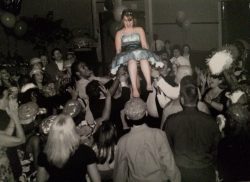
What ever happened to the kids in that photos my daughter wasn’t friends with after seventh grade? The kids with the hats and the smiles, who kicked off their shoes before the first song and danced for four hours? How many of them even really knew why there were there except that it was a party? I look at someone I don’t even recognize and decide what her story was on that night. She looks happy but wasn’t. I look at someone else and decide it was the best night of their life. I see people who didn’t know they’d die and others who didn’t know how fully they’d live. For others, I make it up. I think they’re the lucky ones.
What make-believe stories about people you don’t know do you see in the photo?
You know I’ve had to set aside my WIP to edit Left To Chance, but the WIP is the only novel of mine to be inspired, in part, by a photo. It was the first time I looked at a photo and had to tell the story. Had to make up the story. Here’s the photo, taken in South Haven, Michigan in the summer of 1955.
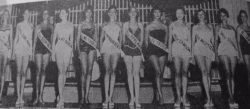
This week (tomorrow, actually, if the weather holds) I’m going to CARPE DIEM (oh, did you read The Good Neighbor, remember Darby? I am loving the way life is taking a bite out of fiction here). I’m blowing this pop-stand for a day to pound some pavements in the town in which WIP is set. The story is set from about a week before Memorial Day to just after Labor Day, so it’s perfect timing. It’s also perfect timing for me to have a day away from everything with a friend, something I haven’t done since this time last year.
Since I started this novel-writing gig I have wanted to be promoting one book (The Good Neighbor), editing one book (Left to Chance), and writing another (The Last Bathing Beauty).
It’s totally fun, in an exhausting kind of way, when you add in a part-time day job, freelance editing, and life.
The committee in my head is working overtime.
***
In the land of edits, I am using highlighters in addition to index cards for this round of edits on LEFT TO CHANCE. My deadline is July 25th and the changing and adding and tweaking (not twerking) has begun. I’ve decided to take the advice and wisdom of others and sift through it to find the particles of gold left behind, and to mix that with what I’ve come up with as my own shiny solutions to a few issues. This is the result of two things — growing confidence in my ability to get shit done in a novel, and my love of a challenge against myself.
One thing I’m sticking with is the epigraph: “You can’t get away from yourself by moving from one place to another.” –The Sun Also Rises, Ernest Hemingway
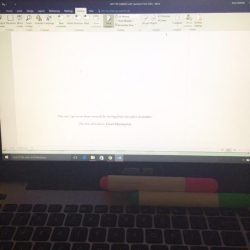
I found this quote (not while reading Hemingway, I admit) and it fit Left To Chance perfectly. Done. The epigraph in The Good Neighbor is “You can never go home again, but the truth is, you can never leave home, so it’s all right.“–Maya Angelou. The Glass Wives has a question as its epigraph, one posed for the reader to ponder before she reads the book. When the glass shatters, who will be there to pick up the pieces?
When I visited Hyde Park, the FDR Presidential Library and Roosevelt homestead, in April, I found the perfect quote for my WIP.

So tell me. How do you choose an epigraph for your novel?
Amy xo
P.S. If you’ve read The Good Neighbor, would you consider leaving a review? Amazon is a great place to start, and you can leave the same review (cut and paste, baby) on B&N, Goodreads, or any of your favorite bookish sites. Reviews help authors like me get noticed by new readers and by the sites that sell our books.

May 25, 2016
Guest Post: How One Photo Inspired A Debut Novel by Author Nicole Meier
One of the coolest parts of being a published novelist is being asked to “blurb” books. That means either the author or the editor or agent reaches out and asks you to read and endorse a new book, if you like it. Authors can’t always say yes, but when we do, we cross all our crossables that we’re going to like a book, find it within our moral wheelhouse to add our own name to it’s front, back, or inside. It’s not a given. A few times I’ve been unable to read a book because the subject matter didn’t sit right with me, so I politely declined. Luckily, I’ve not read a book I’ve felt unable to blurb. I think that means the right folks are asking!
Like Nicole Meier!
Here’s my blurb for The House of Bradbury, Nicole’s debut novel:
“Just as inspiration hits struggling writer Mia Gladwell, she agrees to take in a recovering young starlet. With Ray Bradbury’s former home as its backdrop, Nicole Meier weaves a delightful tale of accidental friendships and second chances.”
Today, we have Nicole here on WFW sharing how a photograph sparked the story for her novel.
Please welcome Nicole Meier to WFW, and share your novel’s inspiration in the comments!
Amy xo
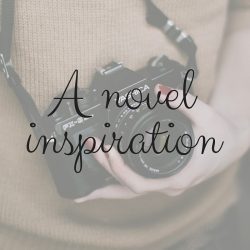
How One Image Sparked a Novel
By Nicole Meier
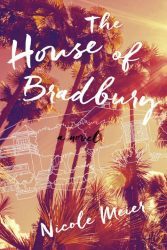 One picture is worth a thousand words. Or in my case, seventy-five thousand. This statement pretty much sums up the origin of my debut novel, The House of Bradbury. It was actually the discovery of a single image that snared my attention and caused me to stop everything else I was working on to find out more.
One picture is worth a thousand words. Or in my case, seventy-five thousand. This statement pretty much sums up the origin of my debut novel, The House of Bradbury. It was actually the discovery of a single image that snared my attention and caused me to stop everything else I was working on to find out more.
A couple of years ago, I came across a Los Angeles Times article that read, “You can live in Ray Bradbury’s house for just $1.5 million.” Included in the article was the real estate photo of the home’s exterior. The charming 1930’s traditional-style architecture, with its bay windows and red tiled roof, piqued my interest. I could tell from the snapshot of the cheery yellow house, where Ray Bradbury resided for half a century, that the interior was full of stories. Like my protagonist, I wanted nothing more than to get inside and discover its secrets.
I’ve been a Bradbury fan since my teens, when I first discovered Fahrenheit 451. Over the years, I’ve admired him for his fantastical books and unique perspective on the culture in which he lived. Plus, he was such a proponent of writers everywhere. You’d be hard-pressed to find another author of his caliber who generously offered so much thoughtful advice to other writers. He was a big fan of the art of storytelling.
Around the time of the article, my twin daughters were studying his short stories in their middle school class. Rediscovering tales like The Veldt through my children’s eyes made me fall in love with Bradbury’s work all over again. So it felt like the perfect storm of rediscovering his work and learning about his empty home that inspired me to create my story. I wanted to imagine a modern day writer taking up residence, hoping to soak up any creative vibrancy the iconic author might have left behind. I wanted to portray someone who was charmed by the worn finishes and dated décor. All of these details served as a roadmap to Bradbury’s daily life. I imagined who might pick up that map and make use of it.
With the intensity of an art curator, I pored over photos, videos, and magazine articles featuring Bradbury’s home. I wanted to know the layout of the rooms, the color of the hardwoods, and the design of the wallpaper. I clipped image after image, pasting them up where I could study and piece together the bones of the house. These pictures drove my narrative and helped me develop the characters.
As my research continued and my story began to unfold, I learned that an LA-based “starchitect” had purchased the property with plans to raze it to the ground. This news was devastating. As a Southern California native, familiar with the neighborhood, I wanted to envision a world where the house wasn’t demolished, but instead purchased by an appreciative fan. In this respect, I did my best to keep the details of the dwelling alive. I suppose you could argue that the house itself became a main character. After all, it was the reason the story existed in the first place.
Now that the book has been released, people tell me they’ve looked up the home and reacquainted themselves with Bradbury’s work. Nothing makes me happier. While my story is fictional, I hope to share some of the author’s inspirational spirit with my readers. And where better to start than to offer a glimpse at his house?
I’m fairly certain all my future stories will be inspired by photography in some form or another. So far, it’s been a pretty good muse.
 Nicole Meier is a native Southern Californian who pulled up roots and moved to the Pacific Northwest. She works as a freelance travel and lifestyle writer. She lives in Oregon with her husband and three children. The House of Bradbury is her first novel.
Nicole Meier is a native Southern Californian who pulled up roots and moved to the Pacific Northwest. She works as a freelance travel and lifestyle writer. She lives in Oregon with her husband and three children. The House of Bradbury is her first novel.
nicolemeierauthor.com
Twitter: @nmeierwrites
Check out THE HOUSE OF BRADBURY HERE!

May 23, 2016
Guest Post: Balancing Fiction with Fact in Historical Novels by Gina L. Mulligan
Hi friends! Wonderful advice today from author Gina L. Mulligan on balancing fiction and fact in historical novels. It’s something I think about as I read historical fiction, or even novels with historical threads or bits mixed in.
If you’ve written historical women’s fiction, how did did you balance fact with fiction? Have you thought about incorporating historical bits into your work? I have, and it’s daunting! Of course, I love a challenge and that makes me want to do it even more. (Who am I kidding, I’ve already begun doing it for novel #4).
Please welcome Gina L. Mulligan to WFW, and share your thoughts in the comments!
Amy xo

The Historical Novel; Balancing Fiction with Fact
by Gina L. Mulligan
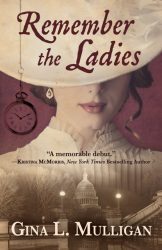 Mark Twain said, “Fiction is obliged to stick to possibilities. Truth isn’t.” As an author of historical fiction, I’m often asked about the decision making process behind how much actual history to include in the historical novel. Where is the imaginary line between truth and creating an authentic fiction? This is the same question that haunts every historical fiction author I know. We want our stories to reliably represent an epoch or specific event, and yet at the same time fiction needs the freedom of imagination and reinvention. That’s what makes historical novels fun to read, and write. So after many years or researching, writing, editing, and more editing, I’ve developed a system to help balance fiction with fact.
Mark Twain said, “Fiction is obliged to stick to possibilities. Truth isn’t.” As an author of historical fiction, I’m often asked about the decision making process behind how much actual history to include in the historical novel. Where is the imaginary line between truth and creating an authentic fiction? This is the same question that haunts every historical fiction author I know. We want our stories to reliably represent an epoch or specific event, and yet at the same time fiction needs the freedom of imagination and reinvention. That’s what makes historical novels fun to read, and write. So after many years or researching, writing, editing, and more editing, I’ve developed a system to help balance fiction with fact.
How I find an idea for a novel influences where I start. Often a story idea is sparked while doing research for another project; stumbling upon some fascinating kernel that makes me stop and wonder. That’s a good first sign. If unfamiliar with the era, I read a bit and get a general feel for the time period. Google is great as long as I don’t go down the rathole and never get to writing. When I work on something familiar to my current area of focus, The Gilded Age, I outline the plot and story points and complete a rough first draft without doing much research at all. This is where I get to play. When unsure about a point of history, I put in a placeholder and keep going.
With a first draft ready, I then hit the books. I find library reference books, old newspapers, and non-fiction research on specific subjects, like period dress or politics of the day, are most useful. And I love reading books written in the era. If Henry James mentions a sea-fairing cap with big ear lappets then so can I.
With a healthy list of historical information created ─ that usually includes quotes, important figures and events, unique goods of the day, and food choices ─ I select the elements that I definitely want to include. This is either because it’s absolutely relevant to the story or just too fascinating to leave out. I again go through the novel and add in the particulars I’ve chosen. Plus, when I feel the story needs more depth to enhance the realism, I have my hit list of details at the ready. I admit I have a fondness for lyrical era terms that sometimes gets me into trouble.
With my history in place I tackle another round of edits, and that’s when something funny happens. I take back out many of the historical references I just added in. Other authors I know do the same. Too many facts can slow the pace and burden a reader. Fiction is what makes every novel unique; which means enthralling trivia can’t overshadow or interfere with the story. All the research, however, is still essential. Readers rely on the author as an expert on the subject, whether or not every juicy morsel is on the page.
There are a few rules authors must follow. Readers expect authors to keep true to the big stuff like major events and inventions that are appropriate. No toasters in 1888. For safety, I also avoid words that are old but sound modern. Who knew that the term “unfriend” was first noted in the late 13th century and used in the 19th century.
In the end, I strive to keep my historical novels believable enough to draw the reader into a new world, take them on a compelling journey, and leave them with a fresh perspective and a few new facts. If I can do that, then the balance is just right
 Gina L. Mulligan is the author of Remember the Ladies, a historical fiction about women’s suffrage in America. She began her writing career over twenty years ago as a freelance journalist for national magazines. Her short stories are in included in the anthologies Tudor Close: A Collection of Mystery Stories and Not Your Mother’s Book . . . on Dogs, and were performed at Stories on Stage Sacramento. She has won awards from the Abilene Writers Guild, San Francisco LitQuake, and the Soul-Making Keats Literary Competition.
Gina L. Mulligan is the author of Remember the Ladies, a historical fiction about women’s suffrage in America. She began her writing career over twenty years ago as a freelance journalist for national magazines. Her short stories are in included in the anthologies Tudor Close: A Collection of Mystery Stories and Not Your Mother’s Book . . . on Dogs, and were performed at Stories on Stage Sacramento. She has won awards from the Abilene Writers Guild, San Francisco LitQuake, and the Soul-Making Keats Literary Competition.
After her own diagnosis, Gina founded Girls Love Mail, a charity that collects handwritten letters of encouragement for women with breast cancer. She was honored for her charitable work on the nationally syndicated television talk show The Steve Harvey Show.

May 22, 2016
The Writing Life #8
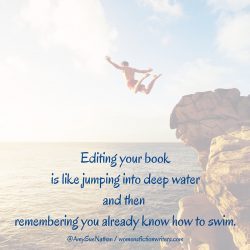
This was a big week in my writing life! I spoke with my editor about my third novel, Left To Chance, how to make it better, how to make it the book I want it to be. So, I’ll be diving into the pages again, visiting my beloved Chance, Ohio. I can’t wait until you can visit as well!
At first, I was nervous. I’ve spent the past eight weeks away from this story and these characters, steeped in my first draft and research for book #4 (Boop! How I love Boop! How I want to write more Hannah and Boop!)
But what I realized when I unlocked the door to Left To Chance, was that it was as if I was visiting with that old friend I only saw once a year. You know, how you can see that certain someone infrequently and pick up right where you left off, as if you’d just walked around the corner and come right on back, when months or even years have passed.
But unlike a comfortable friendship, a book edit presents challenges along with its embrace. Luckily, I love a challenge.
This one I will tackle with index cards.

My editing often results in quite a bit of rearranging. This is not new for me, but the use of index cards is new. I used multicolored cards to create a balanced timeline for the novel, to make sure that the who and what and where were varied and made sense. Now I’ll use the card to pull out pieces of the manuscript that need to be re-purposed. I can see them, touch them, and move them around the old-fashioned way. I also have the opportunity to create index cards with new tidbits, new pieces to be added into the story.
Edit is not a four-letter-word.
***
On social media, I’ve taken more of an interest in Instagram. You can follow me — wait for it — @AmySueNathan. I’m finding it a good way to wake up my workday. Here’s a recent photo of my writing books #shelfie. The shelf does not include the writing books I keep by my bed, ‘natch.
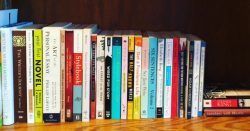
If you’re looking for a great read on author social media, check out Andrea Katz’s blog post on Great Thoughts. And like all advice on writing or the writing life, take what you need and leave the rest. I think there’s something there for everyone, but not everything is for everyone, as usual. If you’re not familiar with Andrea’s FB group, Great Thoughts Great Readers, take a look at that as well. It’s a place for readers to connect, share books they love in threads, book clubs, giveaways, and to connect with authors as well.
See you this week on WFW for two great guest posts!
Amy xo
May 16, 2016
Guest Post: 4 Tips For Making Sociological Issues Shine In Fiction by Author Adria Cimino
Today we have Adria Cimino with us to share her thoughts on weaving serious contemporary issues into fiction, which she does in her novel, The Creepshow. I met Adria through Tall Poppy Writers. She’s always on the go – writing books, publishing books, promoting books. You can also check Book Star in the left hand columns—that’s another brainchild of Adria’s, along with her friend and business partner, author Vicki Lesage.
But now, back to our business!
What real life issues do you weave into your fiction? Any tips of your own to share?
Please welcome Adria to WFW!
Amy xo
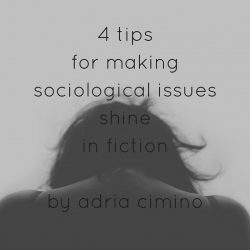
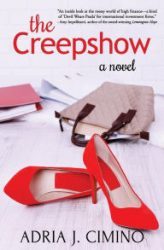
Discrimination, sexual harassment, bullying… Should these and other sociological issues have their place in fiction, or are they best suited to nonfiction territory? We’re so used to seeing them in the nonfiction section of our local bookshops; there’s no denying the fact that you’re more likely to read about the glass ceiling in a nonfiction book than in a novel.
But that doesn’t mean these troubles are poor material for fiction. And the more I considered the possibility, the more I became convinced that these subjects would make for great fiction. They are, unfortunately, real and familiar to many. So wouldn’t it be logical that some of our favorite protagonists face these situations like so many of us? And another reason: Not everyone reads nonfiction. Fiction offers us as writers a vehicle to reach another audience with important messages.
Still, writing about sociological issues in fiction does present challenges. The first one being this: If I think “nonfiction” when I hear the words “glass ceiling, discrimination and sexual harassment,” chances are, so will a lot of readers! Second problem: How to write a book with such an issue and keep it spicy? In my case, I was interested in writing a novel about the glass ceiling. With that, images of sterile (or not so sterile) offices filled my head. Business suits, briefcases, 12-hour days. Not exactly glamorous, exciting or even attention-getting.
And then—not so suddenly, but more like gradually over many cups of tea and various snacks—the answer came to me. Relationships tie everything together in a good novel. A novel incorporating a sociological issue would be no different.
My glass ceiling novel, The Creepshow, would be a relationship story after all, but the protagonist’s troubles at work would be the guiding force, affecting her, her relationships and her decisions. The key to incorporating a real-life issue that to some might seem a bit dry is to emphasize how said-issue impacts the human relationships in the story.
Our characters don’t experience life in a vacuum, and neither do we. If your character is facing abuse/harassment/racism/bullying etc. here are some questions to ask yourself to give your story more depth, as well as a few ideas about how to write accordingly:
How is the situation affecting the protagonist’s view of herself? If it’s hurting her self-esteem, for instance, she might not react in a “logical” way or in the way we’d like her to react.
How is the situation affecting the protagonist’s relationships? Is it bringing her closer to the people she loves or for some reason is it driving her away from them? And why? Your character might surprise you, and if she does, listen. Don’t be afraid to go the unconventional path if it indeed suits your character. And don’t be afraid of disappointing the reader. This isn’t about catering to what an audience supposedly will want.
How will the protagonist change as the difficult situation progresses? Most good stories show a character’s growth in some way or another. In this case, we should see a change in the character’s attitude and way of handling her relationships, as well as the difficult situation.
What roles will your supporting characters play throughout? Will they truly understand what the protagonist is going through? In many cases, the answer will be “no, they don’t understand.” And that’s a good thing, adding tension and an opportunity for the protagonist to win over this character, and the reader.
By considering these questions, and developing meaningful relationships, shaped by your protagonist’s challenging situation, the main issue in your book will become part of an interesting multi-faceted story. Now that doesn’t mean everyone will understand or approve of your choices—but that is the case when we write a book on any subject!
Including a sociological issue in your fiction might be intimidating at first. But if you’re passionate about the issue and you carefully plan how to develop the characters involved in the action, it can not only make for a great book, but it also can make for a meaningful one.
 Adria J. Cimino is the author of Amazon Best-Selling novel, Paris, Rue des Martyrs, and Close to Destiny, as well as The Creepshow and A Perfumer’s Secret. She also co-founded boutique publishing house Velvet Morning Press. Prior to jumping into the publishing world full time, she spent more than a decade as a journalist at news organizations including The AP and Bloomberg News. Adria is a member of Tall Poppy Writers, which unites bright authors with smart readers. Adria lives in Paris with her husband, Didier, and daughter, Phèdre. When she isn’t writing, you can find Adria at her neighborhood café watching the world go by.
Adria J. Cimino is the author of Amazon Best-Selling novel, Paris, Rue des Martyrs, and Close to Destiny, as well as The Creepshow and A Perfumer’s Secret. She also co-founded boutique publishing house Velvet Morning Press. Prior to jumping into the publishing world full time, she spent more than a decade as a journalist at news organizations including The AP and Bloomberg News. Adria is a member of Tall Poppy Writers, which unites bright authors with smart readers. Adria lives in Paris with her husband, Didier, and daughter, Phèdre. When she isn’t writing, you can find Adria at her neighborhood café watching the world go by.
Website: http://www.adriajcimino.com/
Facebook: https://www.facebook.com/AdriaJ.inParis
Twitter: https://twitter.com/Adria_in_Paris
Amazon: http://www.amazon.com/Adria-J.-Cimino/e/B00IBW3X5I
May 15, 2016
The Writing Life #7
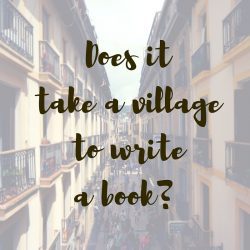
You betcha! At least for me it does.
But—I don’t mean just mean the characters who exist inside my head and pop into my thoughts telling me their names and deepest secrets.
I don’t mean only mean my thoughtful beta readers who read a finished manuscript and ask questions and offer the constructive criticism I have asked for.
I don’t mean simply mean my insightful agent or smart editor who seem to know just the right buttons to push to help me arrive at decisions about a story on my own, or nudge my skill to the next level (and yes, that’s their job, but still… ).
I do mean the village of writers that I intentionally and, even sometimes accidentally, reside within. Or, as my Southern writer pals would say, y’all.
While none of you are bringing me coffee so I don’t have to get up and can keep on writing (but, come to think of it, if anyone wants to…) the emotional construct of writing for me, relies upon knowing that when I step outside my writing cave, that you will be there. That makes the solitude I require for typing words onto a screen, quite manageable. I’m a leave-me-alone-shut-off-the-music-shut-up-don’t-talk-to-me kind of writer. I’m not in a coffee shop or a library. I don’t listen to music. I’m alone in a room, on the chaise, gifted to me by my agent. This is where I write.

Nowhere was the effect of a village made more evident to me than Saturday at the Writing Workshop of Chicago 2016 (#WWOC16), where I met dozens of aspiring authors. (These workshops are held all over the country, so check a city near you!) I conducted sixteen in-person, ten-page manuscript critiques, as well as two one-hour workshops. I spent the day talking about—and listening to others talk about—writing and being a writer. When I walked out of the hotel and headed to the train, nearing the end of my twelve-hour day, my most prevalent thought, aside from IT IS WAY TOO COLD IN CHICAGO TODAY was, that all day long I was right were I was supposed to be doing what I was supposed to be doing with the people who I was supposed to be with.
I spent the day in my real-life village.
What a gift.
And that, made me want to come home and write a book.
Amy xo
Click to view slideshow.
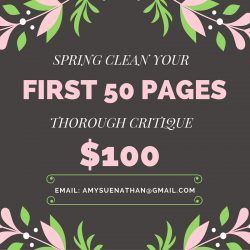
May 12, 2016
Blogging is like an extreme sport…
when you hit PUBLISH instead of SAVE DRAFT on a half-written blog post and wish it really were THROWBACK THURSDAY so you could throwback to when that hadn’t happened on this Thursday and you race to hide it and can’t so you delete it which means you’ll start from scratch with that one another day.
Thanks to Christine Orchanian Adler for the quick email. Now, let’s get back to our regularly scheduled amazing post by Sally Koslow.
May 11, 2016
Guest Post: 4 Book Writing Secrets by Author Sally Koslow
Today, my friend and friend to all writers, Sally Koslow is giving us her secret sauce for writing success! Sally hails from the world of magazines (where she was a big-time editor, until she wasn’t (read Little Pink Slips).
Today, Sally uses her talent to write novels but she keeps magazines close to her heart and the lessons she learned, right at hand.
Please welcome Sally Koslow back to WFW!
Amy xo
4 Book Writing Secrets from Magazine-Land
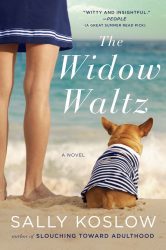 Once upon a time—a long, lovely time—I was an editor and/or writer on any number of mass-market magazines you may know, though my resume also features titles that reside in the graveyard. (Rest in peace, Mademoiselle, McCall’s, and Lifetime.) A few years after I started, I began to write articles of about 4000 words, the standard length back in the day. I wasn’t exposing corruption, but the subjects were serious, like incest (for Glamour) and loveless marriage (for Ladies’ Home Journal.) Over time, I inched up the masthead and stayed put at the thrilling top. There I rarely wrote anything longer than a “How Not to Get Fat After 35” cover-line or a haiku-length editor’s editor. By then, the pieces in most magazines had, like women’s underwear, shrunken. A little more than ten years ago, when I left my last magazine editorial staff, “long” articles were thong-like wisps of about 1200 words. Too often they were about a Kardashian.
Once upon a time—a long, lovely time—I was an editor and/or writer on any number of mass-market magazines you may know, though my resume also features titles that reside in the graveyard. (Rest in peace, Mademoiselle, McCall’s, and Lifetime.) A few years after I started, I began to write articles of about 4000 words, the standard length back in the day. I wasn’t exposing corruption, but the subjects were serious, like incest (for Glamour) and loveless marriage (for Ladies’ Home Journal.) Over time, I inched up the masthead and stayed put at the thrilling top. There I rarely wrote anything longer than a “How Not to Get Fat After 35” cover-line or a haiku-length editor’s editor. By then, the pieces in most magazines had, like women’s underwear, shrunken. A little more than ten years ago, when I left my last magazine editorial staff, “long” articles were thong-like wisps of about 1200 words. Too often they were about a Kardashian.
At that point I had an itch to return to writing, but the last thing I imagined myself completing was a book. Magazines had seemed a perfect fit because I had the attention span of a mayfly. Books cared the bejesus out of me. How did authors maintain interest in one topic or storyline for, quite possibly, two or more years? I‘d read the musings of writers who humble-bragged that a particular book idea had grabbed them so intensely that they’d finished it in only six months. Six months on one blinking project? I’d sooner write assembly instructions for Ikea, or so I originally thought. Yet in the last twelve years I’ve been able to trick myself into writing, roughly, six and a half books: four published novels; one published non-fiction book; two unfinished, probably-never-to-be-published novels (may they also rest in peace) as well as one historical novel on which I’m joyously progressing, and hope to finish by next fall. All of the books were printed in both hardcover and paperback, some in foreign languages.
Whatever I’ve accomplished, I owe in part to magazines. This is what they’ve taught me:
1. We all need a deadline. On a magazine, you juggle a jillion deadlines. Let’s say you work on a big monthly, as I did. The magazine’s managing editor, an ogre disguised as an efficient woman with a clipboard, breathes down your neck every twenty minutes until you get it done…. whatever “it” is. Every day you have numerous deadlines, as does everyone on the team. Eventually, the whole magazine, with all its moving parts, comes together, gets sent to the printer, and the cycle starts all over again. Actually, cycles overlap. You work on the December issue when you’re finishing June, blah blah. Ten-hour days fly by in ten minutes.
What I realized from my years of deadlines was that without a defined time frame and declared cutoff, most people merely perseverate and write nothing. A finishing line is a mirage. Writing a book requires flinty discipline: a potential author needs to give herself a deadline until she’s lucky enough to land a contract, and she receives a deadline from an editor. The fastest way to get a deadline is to enroll in or form a writing workshop where you agree to submit manuscript pages at regular intervals. To meet these deadlines, you must impose additional deadlines on yourself. (This is harder.) You need to tell yourself you will not stir the stew until you’ve written to the bottom of the page, and you’ve got to mean it. You also need to create a schedule and honor it. I, for example, find that I work well in the morning but sag as the day goes by. Knowing this, I pretend I still work in an office, sit myself down at dawn (this is why exercise clothes were invented) and bang away on my computer. Once I’ve done a draft, I turn myself back into a magazine editor and ruthlessly polish.
2. Write tight. Not only do magazines have a finite number of pages, for decades most of them have been designed so pieces end on the bottom of a page. The elements fit together like Lego blocks. (Butt out of this conversation, Vanity Fair.) This requires editors to deftly cut articles and chunks of copy to fit the space designated on a layout without ruining the flow of words and thought. A writer of books should apply the same rule and ruthless trim to eliminate padding that fails to move her story forward. It helps to pay attention to authors who do this well. In The Life of Lucy Barton, for example, the Pulitzer prize-winning author, Elizabeth Strout, is a magician able to reveal character and narrative as much as by what isn’t on the written page as what is.
3. Divide and conquer. A magazine is a collection of long and short articles, columns and visual elements. Even more so, books, though with fewer or no visuals. Try not to picture your growing manuscript as a 100,000-plus-word behemoth. Think of it as a collection of small parts and concentrate on only one at a time –the scene you want to finish, not even a whole chapter. When I wrote Slouching Toward Adulthood: Observations from the Not-So-Empty Nest, I decided to consider it fourteen magazine articles rather than one lengthy book. With any manuscript, you will find that once you get to the two-thirds-completed point, the last third will be easy. Don’t ask me why, but momentum will carry you the distance. I promise.
4. Learn from the competition. Magazine editors always case other magazines. Sometimes it’s to stay on top of freelance writers, photographers and illustrators they might hire, but it’s also to be inspired. When I wrote my first novel, Little Pink Slips, loosely based on my experience when a certain brash celebrity took over McCall’s and kicked my sorry butt upstairs (not that I’m bitter,) I deliberately stayed away from reading books in the same genre, for fear that I might inadvertently copy them. Big mistake. I’ve gone from that extreme to reading as much as I can—which for me means inhaling a book about every five days–hoping to be infected by other, and often better, writers’ work. I tend to focus on novels and memoirs I consider to be of high quality—which, of course, is different for each of us—and try not to get dragged down by humdrum writing. In order to justify the investment of time reading a whole book requires it needs to be special in some way. I also try to cheerlead for other authors, posting reviews on Amazon, Goodreads and Twitter.
The book-writing world is a community. We all need each other—whether or not we also love magazines. I always will.
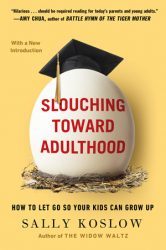
 Sally Koslow is the author of the novels The Widow Waltz; With Friends like These; The Late, Lamented Molly Marx; Little Pink Slips and one non-fiction book, Slouching Toward Adulthood: Observations from the Not-So-Empty Nest. She contributes essays and articles to many publications and websites, including The New York Times, Theatlantic.com, More, Real Simple, O the Oprah Magazine and was featured in the anthologies Wedding Cake for Breakfast and DIRT: The Quirks, Habits and Passions of Keeping House. Sally teaches at Sarah Lawrence College’s Writing Institute and at various venues in the New York City area. Previously, she was the editor-in-chief of a number of magazines, including McCall’s. She also works as an independent writing coach. You can reach her through www.sallykoslow.com, @sallykoslow or www.facebook.com/SallyKoslowAuthor. She belongs to the New York Writers Workshop and Tall Poppy Writers.
Sally Koslow is the author of the novels The Widow Waltz; With Friends like These; The Late, Lamented Molly Marx; Little Pink Slips and one non-fiction book, Slouching Toward Adulthood: Observations from the Not-So-Empty Nest. She contributes essays and articles to many publications and websites, including The New York Times, Theatlantic.com, More, Real Simple, O the Oprah Magazine and was featured in the anthologies Wedding Cake for Breakfast and DIRT: The Quirks, Habits and Passions of Keeping House. Sally teaches at Sarah Lawrence College’s Writing Institute and at various venues in the New York City area. Previously, she was the editor-in-chief of a number of magazines, including McCall’s. She also works as an independent writing coach. You can reach her through www.sallykoslow.com, @sallykoslow or www.facebook.com/SallyKoslowAuthor. She belongs to the New York Writers Workshop and Tall Poppy Writers.

May 8, 2016
The Writing Life #6

This has been a busy week. It’s been so busy that I’m actually writing my Sunday post on Sunday!
The quote above is one that I keep in front of me while I’m writing my first drafts. I try to make sure that each character has a purpose in a scene, even if it’s subtle. I guess that’s true for life as well. I wonder if Vonnegut knew that when he came up with this. I mean, I try to make sure that every person has a purpose in my life, whether it’s life-altering or subtle.
What happens when I write something where the character wants nothing and has no purpose? I might be enamored with my descriptions or my language or my characters’ witty banter, but if I’m honest I know it doesn’t belong. Well, better yet, I make it belong. I figure out what someone wants and make that part of the story right there and then.
For example, where you last left Hannah Peck in my WIP, was admitting she WANTED to stay with Grandma Boop and her friends for the summer. It would have been simpler, perhaps, to just have Hannah enjoying her getaway, admiring her childhood summer home, and lamenting her break-up. But if we didn’t know for sure that what she wanted right there and then was basically permission to stay, we — meaning I — wouldn’t care so much about whether or not she gets what she wants. In the next scene we learn…well wait…here’s the next scene (which brings you to the end of chapter one).
“Time to make the doughnuts!” Boop’s voice rang out as if I were two blocks at the beach and she was calling me for dinner, when in fact, she was standing at the foot of my bed.
I pulled my pillow over the back of my head, only to have it wiggled from my grasp and lifted off me.
“That means it’s time to get out of bed, sweetie.”
I opened my eyes and stared into my drool drenched pillow as I pushed up onto my elbows.
“Good morning, Boop.” I heard the curtains on each window swish open, one after another, and then each shade thumped as it rolled to the window tops. “What time is it?”
“It’s time to make the doughnuts.”
“Yes, I heard you but what do you mean?” Boop had a way of saying what she thought sounded good and attaching whatever meaning was convenient at the moment. I flipped around on the bed, twisting Clark’s long T-shirt like a corkscrew around my middle. I closed one eye as a way to remind my grandmother she’s awakened me from a sound sleep, and to keep out half the light pouring in my third floor windows. She patted down each drapery panel as if she were a TSA inspector with a quota. Then, she folded the chenille blanket into thirds at the foot of the double bed. My bed.
“It means it’s time to get moving. You’ve been lying in bed for two days lamenting that shmendrick.”
“I was with Clark for more than five years!”
“Exactly. Now, it’s time to get to work.”
“I told you I don’t need to work this summer, Boop. I’m looking at this as my transition time.”
“A transition to what?”
“I don’t know yet.”
“Exactly. You have to work on figuring that out.”
I swung my legs over the side of the bed. “And doughnuts are going to help me with this?”
Boop sighed so deeply her shoulders lifted to her ears and then returned to their rightful place. It felt as if she’d filled the room with her exasperation, which today still smelled of lavender.
“It was a just a saying, Hannah.”
“I’ve told you; I’ll pay my fair share this summer. You don’t have to support me.”
“What kind of grandmother would I be if I didn’t support you?”
I was too tired to haggle over hyperbole. “So there aren’t really any doughnuts?”
“You’ll have to come downstairs to find out. But hurry up or Doris will eat them all.” Boop shuffled through the doorway, her slippers sounding like the sand blocks my kindergartners scratched together during music time. Though still in her pale blue housecoat, as she called it, Boop’s hair flipped up and skimmed her neck, pushed back off her forehead by a slim tortoise shell headband as if she were seven. She’d not yet applied any makeup; an idea she’d scoffed at as long as I could remember. Boop did not leave the house without lipstick. She stopped, turned, and walked back into the room, her eyes squinting with intention. Boop opened the small closet door, and tugged on the light’s chain. The naked bulb lit up the clothes I’d hung on hangers and the boxes I’d stacked on the floor that contained the remnants of a life I’d only imagined. The musty scent leapt out and tamped down the lavender. Boop lifted out the only dress I owned and laid it over the brass footboard, splaying the floral skirt in front of me as if it were a decorative fan.
“Wear this today,” she said. “We have plans.”
What does Hannah want? I know, of course. Do you? What does Boop want? Right now it’s something for Hannah. Boop’s own story will come into view soon.
How do you handle this in your own books or WIP? It’s so easy to forget to give your character purpose every step of the way. I keep the image of the water glass in mind, and use that to double-check myself. This want is what fuels your character and compels your reader to turn the page. That’s enough of a reason for me to keep the quote stuck to my laptop!
Exciting news! I’m expecting the edits for LEFT TO CHANCE this week from my St. Martin’s Press editor, the incomparable Brenda Copeland! I’m so excited to get back to Teddi Lerner and her friends, but I’ll be sad to set Hannah and Boop aside for a bit while I put the almost-final polish on this novel.
Next weekend I’m presenting at the Chicago Writing Workshop! Let me know if any of you are there. Even if you’re not in my sessions, wave or come say hi. I’m teaching two workshops and doing sixteen in-person critiques, so the day is packed (I did notice two bathroom breaks and lunch on my schedule, whew!) I can’t wait!
Oh, and just a reminder, as with all writing advice, YOUR MILEAGE MAY VARY. These posts are not mandates, they are opinions. I’m sharing what works for me and if it doesn’t work for you, THAT’S OKAY. There’s no right way or wrong way, just what’s right or wrong for me or you. As with everything writing-related here and elsewhere, take what you need and leave the rest.
Amy xo

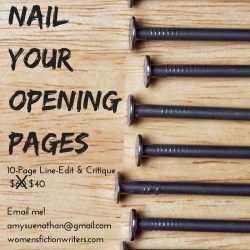
May 4, 2016
Guest Post: Tips For Writing Historical Fiction by Author Aimie K. Runyan
Today we have debut author, and fellow Tall Poppy Writer, Aimie K. Runyan, here to talk to us about writing historical fiction for today’s reader, how to make the values and sensibilities of the past resonate with present-day readers. It’s an interesting and insightful post that has given me a lot to think about as I dip into the past for parts of my WIP.
Please share your thoughts in the comments, and welcome Aimie K. Runyan to WFW!
Amy xo

by Aimie K. Runyan
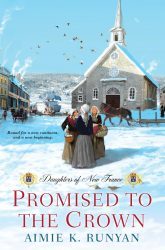 Imagine you’re an attractive woman walking down the street in New York City. A man whistles low and makes a suggestive comment.
Imagine you’re an attractive woman walking down the street in New York City. A man whistles low and makes a suggestive comment.
My personal reaction would be to extend my middle finger and tell him what to do with his inappropriate comment. I’d be furious at the man’s untoward behavior because I live in a time where such actions aren’t considered acceptable. Your mileage may vary.
Backtrack to the year 1956. How would a woman from that period react? More than likely, she would pretend she’d never heard the comment in an attempt to avoid confrontation. She was raised to believe ‘boys will be boys’ and that a woman ought to stay away from conflict if there is any option to do so. Her reaction would primarily be fear, not the anger many modern women would feel.
It may seem self evident, but people even fifty or sixty years ago had a different worldview than people today. If you’re writing a piece set in the 1950s, and character berates the cat-caller for his comments, that ‘s a unique choice that you would have to justify somehow or risk being called anachronistic. Perhaps she was raised by progressive parents? Maybe she’s had a negative experience with this sort of man in the past? If you want to escalate the argument, you need to provide some backstory or rationale for the woman to act in a way that contradicts the expectations for a woman in that time.
Now let’s kick it up a notch. Imagine that you’re writing about a woman born 350 years ago. A person so far removed from the modern time isn’t just a quaint, archaic version of ourselves. Their perspective is so different, they would be almost alien to us in their way of thinking. A woman from this time would not (necessarily) balk at her husband ordering her about. She would likely be minimally educated and probably illiterate. She would live with the understanding that her infant child had a one in three chance of dying before adolescence. Not only is it a challenge for a writer to remove her 21st century lens to encapsulate on the page the emotional realities of living in this era, but even harder still to make this character relatable to a 21st century reader who might prefer to leave those comfy lenses on.
One way writers make the characters more relatable to the modern reader is choosing characters from the upper classes. We see many more books about Queen Elizabeth I than we do about the villagers from her reign trying to ward off the plague. The nobility and wealthy merchant class had access to education and privileges that give them much more in common with today’s reader. But not every book needs to be (or should be) about the elite classes. A common girl with a convent education or a young lad who is sent to travel can be an excellent tool for showing the working classes from a more point of view that 21st century readers can still appreciate.
Childbearing and rearing is a particularly interesting topic to tackle. If your character gives birth in the 17th century, you must decide if she will force herself to have a detachment from the child because she knows that the chances of the baby’s survival is slim, or perhaps have the mother lavish the child with all the love she has to give, precisely for the same reason. Location, social class, and the character’s past will all play into your decision as well. For example, in New France, the pressure for women to have large families was immense. I have a character in Promised who has fertility issues, and clearly has no access to have them treated. Every miscarriage and loss she suffers is felt keenly because she knows that the society in which she lives judges her worth by the size of her family. This enabled me to let her feel the loss in such a way that makes the reader sympathetic with her plight. The woman who has a stillbirth and goes back to the field the same day, apparently unmoved by her loss because she has eight other children plowing by her side is a character that is much harder to relate to.
As with most things, the key is balance. If I make my characters too relatable, too modern, there isn’t much of a point in writing a historical novel. My characters had a different relationship with the world than my readers and I do, and it’s necessary to respect those differences. By making some strategic choices, the writer can create a character that reflects their time and appeals to modern sensibilities. In the end, the human experience is universal one, and despite the marked differences people had from us, 350 or even fifty years ago, there is still a common thread upon which the author can build a relationship between the character and reader that transcends the mores of the eras they inhabit.
 Aimie K. Runyan is an author of historical fiction whose purpose is to celebrate history’s unsung heroines. Her debut novel, PROMISED TO THE CROWN, the story of three women sent by Louis XIV to help colonize his Quebec colony, released in April, 2016 from Kensington Books. She lives outside Denver with her loving husband and two adorable children.
Aimie K. Runyan is an author of historical fiction whose purpose is to celebrate history’s unsung heroines. Her debut novel, PROMISED TO THE CROWN, the story of three women sent by Louis XIV to help colonize his Quebec colony, released in April, 2016 from Kensington Books. She lives outside Denver with her loving husband and two adorable children.
Author Website: www.aimiekrunyan.com
Facebook: https://www.facebook.com/aimie.runyan.author
Twitter: @aimiekrunyan
Blog: aimiekrunyan.com/blog
Goodreads: goodreads.com/AimieKRunyan

Women's Fiction Writers
- Amy Sue Nathan's profile
- 543 followers



